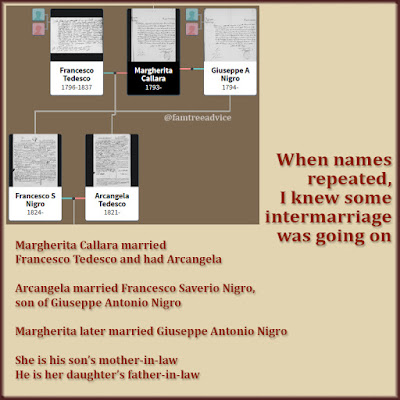Were government regulations the reason so many infants died?
It was a surprise to see where my grandfather and 2 great grandfathers were born. The address is right on their birth records. I knew the Iamarino family had land and several houses well outside of the center of town. Why were they born right near the church?
If they were modern-day Americans, they might move to a bigger, better house. But this was the late 1800s–early 1900s. They didn't move.
The solution to this mystery came from my cousin in Italy. Her sister still lives on the old Iamarino land, far from the center of town. My cousin told me that in the old days, when a woman knew she was going to give birth soon, she would go to a house closer to town. It may have been a house that the family kept for this purpose.
 |
| If you have to walk a newborn infant into town, the baby may as well be born close to town hall. |
The woman needed to be close to a midwife when her time came. She couldn't wait hours and hours while someone rode a mule into town to fetch the midwife. This is why my ancestors were both born at Via Casale, 36, but their families lived a very, very long ride away.
The idea of a convenient place to give birth helped solve another mystery. I always wondered how new fathers in the old days could take a newborn baby to the town hall to record their birth. And then trot them over to the church to for baptism. When I had babies, they weren't supposed to go outside for at least a week. You took them home from the hospital and stayed put.
But what if the babies were born in a convenient house, close to the town hall and the church? The newborn's journey would be much easier. And less likely to lead to their death.
A father, midwife, or close relative had to report a birth to the mayor's office right away. My ancestors didn't report my great grandfather Giovanni's 1876 birth until 1898! They had to report it then so Giovanni could get married. This involved extra paperwork and probably a fine. Imagine my surprise when I stumbled upon his birth record in the year of his marriage.
I created an online map a while ago to plot many of my Bronx, New York, relatives based on their U.S. census records. It was interesting to see, and fun to imagine, so many relatives living within a few square blocks.
Now I'm wondering how many of my relatives were born in the same convenient birth houses. I can click through street addresses I've recorded in Family Tree Maker. I want to find houses where lots of babies were born.
I focused on the streets I knew were close to the center of town. One address, viewed in Google Street View, has its front door cemented shut. The nearby houses range from lovely to under renovation to flat-out ruins.
Family Tree Maker tells me I have recorded births and deaths of 24 people at this address. The dates range from 1877 to 1902, and they all have one thing in common. All 24 people have the last name Pozzuto.
I have a ton of people named Pozzuto in my family tree because I sought them out. This is a last name that has some connection to both of my parents. I located all the Pozzuto vital records in my downloaded Italian records collection. I worked most of them into my family tree. These 24 are not from the same nuclear family. Maybe this house was the preferred birthing place for an extended Pozzuto family.
 |
| Were all of your rural ancestors born at home, or did they have a special place in town? |
What were the legal requirements for reporting a birth in your ancestral home? To find out, go to the Family Search Wiki. In the search field, enter "civil registration" along with your ancestors' country.
The wiki page for your country should begin with some historical background. Look for the year when the country began enforcing civil birth registration. Italy began civil record keeping in 1809 on Napoleon's order. (He was busy taking over the country at that time.) England began civil record keeping in July 1837. Before these dates, they may have recorded your ancestor's birth at the church. Being French is a good deal because their civil records start in 1792. If your ancestors are German, the beginning of record keeping depends on their exact area. But it was mandatory in all German states beginning in 1876.
I don't think you'll read anything about midwives' practices in the wiki. But as you discover birth records for your family members, check the document for an address. You may find that many members of an extended family have their very first address in common.





